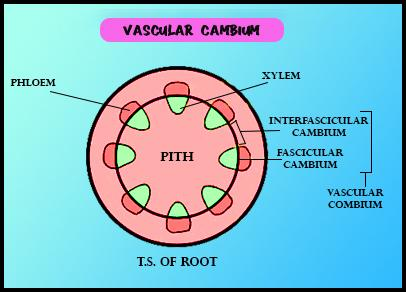
Vascular cambium forms xylem on the inner side and Phloem on the outer side due to
A) Effect of gravity
B) Shearing force of the wind
C) Intrafascicular nature
D) Differential action of hormones
Answer
462.9k+ views
Hint: The formation of vascular cambium is regulated by a network of interacting signal feedback loops which means the signals received from the xylem and phloem act to regulate internal factors of the cambium.
Complete answer:
The reason for the phenomenon that Vascular cambium forms xylem on the inner side and phloem on the outer side is the differential action of hormones.
In the stems of dicotyledonous plants, intra and interfascicular cambium joins to form a ring of cambium known as vascular cambium and produces secondary xylem towards the inner side whereas secondary phloem is formed towards the outer side. It is due to the influence of hormones.
Additional Information:
The vascular cambium is the main growth tissue of stem and roots in many plants especially in dicotyledonous plants as well as some gymnosperms and certain vascular plants. This type of tissue produces secondary xylem towards the pit and secondary phloem towards the bark as shown in the diagram below-
The cambium present between xylem and phloem is known as Intrafascicular cambium and the cells that become meristematic during secondary growth between neighboring vascular bundles from the interfascicular cambium. Both these cambiums join to form the cambium ring separating the primary xylem and primary phloem. This vascular cambium consists of mainly two types of cells
-Fusiform cells
-Ray’s initials.
So, the correct answer is option (D) “Differential action of hormones”.
Note: The hormones involved in the vascular cambium activity are auxins, ethylene, gibberellins, cytokinins, abscisic acid which are vital for the regulation of these activities. The maintenance of the vascular cambium is done by these hormones as well as some short peptides. The various hormones control different regulations of the cambium activities. For example, the auxin hormone is responsible for the stimulation of mitosis, cell production, and regulation of Interfascicular and fascicular cambium.

Complete answer:
The reason for the phenomenon that Vascular cambium forms xylem on the inner side and phloem on the outer side is the differential action of hormones.
In the stems of dicotyledonous plants, intra and interfascicular cambium joins to form a ring of cambium known as vascular cambium and produces secondary xylem towards the inner side whereas secondary phloem is formed towards the outer side. It is due to the influence of hormones.
Additional Information:
The vascular cambium is the main growth tissue of stem and roots in many plants especially in dicotyledonous plants as well as some gymnosperms and certain vascular plants. This type of tissue produces secondary xylem towards the pit and secondary phloem towards the bark as shown in the diagram below-
The cambium present between xylem and phloem is known as Intrafascicular cambium and the cells that become meristematic during secondary growth between neighboring vascular bundles from the interfascicular cambium. Both these cambiums join to form the cambium ring separating the primary xylem and primary phloem. This vascular cambium consists of mainly two types of cells
-Fusiform cells
-Ray’s initials.
So, the correct answer is option (D) “Differential action of hormones”.
Note: The hormones involved in the vascular cambium activity are auxins, ethylene, gibberellins, cytokinins, abscisic acid which are vital for the regulation of these activities. The maintenance of the vascular cambium is done by these hormones as well as some short peptides. The various hormones control different regulations of the cambium activities. For example, the auxin hormone is responsible for the stimulation of mitosis, cell production, and regulation of Interfascicular and fascicular cambium.

Recently Updated Pages
Master Class 11 Economics: Engaging Questions & Answers for Success

Master Class 11 Business Studies: Engaging Questions & Answers for Success

Master Class 11 Accountancy: Engaging Questions & Answers for Success

Master Class 11 English: Engaging Questions & Answers for Success

Master Class 11 Computer Science: Engaging Questions & Answers for Success

Master Class 11 Maths: Engaging Questions & Answers for Success

Trending doubts
Why was the Vernacular Press Act passed by British class 11 social science CBSE

Name the nuclear plant located in Uttar Pradesh class 11 social science CBSE

What steps did the French revolutionaries take to create class 11 social science CBSE

One Metric ton is equal to kg A 10000 B 1000 C 100 class 11 physics CBSE

How did silk routes link the world Explain with three class 11 social science CBSE

Difference Between Prokaryotic Cells and Eukaryotic Cells




